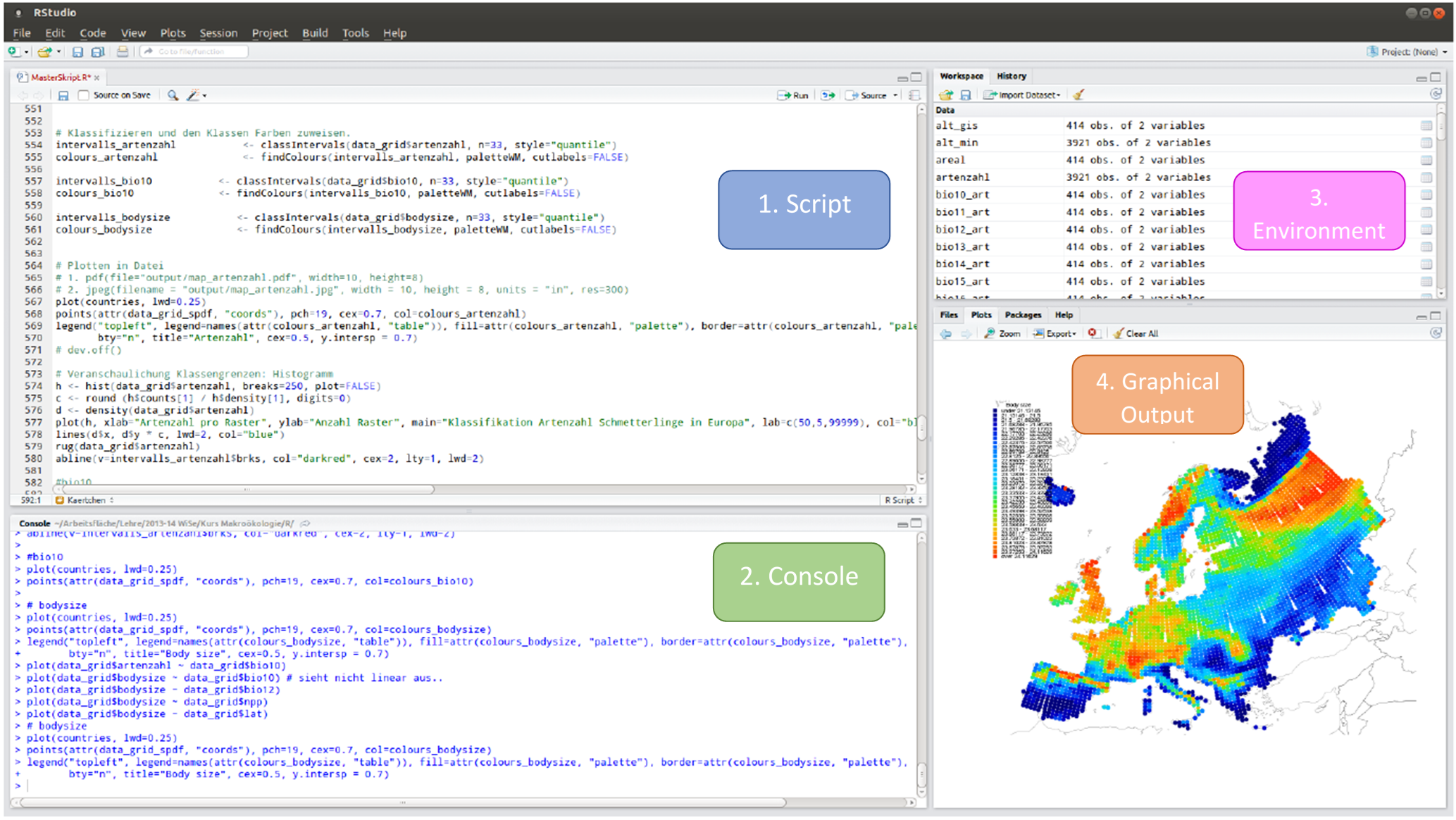Work Environment
“Data is the new oil.” — Clive Humby
What does workspace mean?**
“A workspace is (often) a file or directory that allows a user to gather various source code files and resources and work with them as a cohesive unit.[1] Often these files and resources represent the complete state of an integrated development environment (IDE) at a given time, a snapshot. Workspaces are very helpful in cases of complex projects when maintenance can be challenging.” — Wikipedia

Little reminder from Unit 1:
This is the Integrated Development Environment (IDE) of RStudio. It contains
- the script aka text editor,
- the console for executing code,
- the environment aka the workspace and history management,
- the graphical output but also browsing the workspace, managing packages and information about the help functions.
Now let’s have a closer look at the environment after you have gotten to know the script and the console.
Project directory structure
If you have a project with many data files, analysis scripts or other it is highly recommended that you create a directory structure under your main project folder to store and organize all these files. For example, you might have a project folder under C:/geomoer/Project1, whose directory structure might look like this

The key elements of a project folder include:
- a
Data/folder - an
Process/folder and - an
Output/folder.
The Data/ folder contains all data files which include all raw data files as well as all subsets and manipulated versions of these data files.
The Process/ folder contains sub-directories with analysis files, e.g. R scripts and figures or maps that may be produced by the analyses.
And an Output/ folder stores the final reports e.g. .docx, .pdf, .Rmd files and presentations e.g. .pptx, or .html files.
Understanding the directory structures
You need to explicitly instruct R on how to access a file from the R session’s working directory. Because a data file may reside in a different directory than which the R script is calling it.
In an example, user Geomoer has a project folder called Project1 in which reside a ./Data folder and an ./Process folder. He opens the R script which contains the following line of code and runs it.
data <- read.csv("data.csv")
Error in file(file, "rt"): cannot open the connection
But R returns an error message, which states that the file data.csv cannot be found. This is because the session’s working directory is probably set to a directory other than the C:/geomoer/Project1/Data directory which contains the data file.
An R session’s working directory can be verified by typing the following command:
getwd()
[1] "C:/geomoer/Project1/Process"
The working directory is used to instruct R where to look for a file (or where to create one) if the directory path is not explicitly defined. So in the example above, user Geomoer is asking R to open the file data.csv without explicitly telling R in which directory to look so R is defaulting to the current working directory which is C:/geomoer/Project1/Process which does not contain the csv file.
There are two options to resolve this problem.
The first is to set the working directory to the folder that contains the data.csv file using the setwd() function.
setwd("C:/geomoer/Project1/Data")
The second is to modify the read.csv call by specifying the path to the data.csv file.
dat <- read.csv("C:/geomoer/Project1/Data/data.csv")
Hint: Pay attention to the quotation marks.
Relative and absolute paths
However, this approach makes it difficult to share the project folder with someone else who may choose to place it under a different folder such as D:/Uni/R/Test/Project1/.
In such a scenario, the user would need to modify every R script that references the directory C:/geomoer/Project1/. A better solution is to specify the location of the data folder relative to the location of the Analysis folder such as,
dat <- read.csv("../Data/data.csv")
The two dots .. tells R to move up the directory hierarchy relative to the current working directory. So in our working example, ../ tells R to move out of the Process/ folder and up into the Project1/ folder. The relative path ../Data/data.csv tells R to move out of the Process/ directory and over into the Data/ directory before attempting to read the contents of the data.csv data file.
Using relative paths makes your project folder independent of the full directory structure in which it resides thus facilitating the reproducibility of your work on a different computer or root directory environment.
Absolute and relative paths
An absolute (or full) path points to the same location in a file system, regardless of the current working directory. To do that, it must include the root directory. For example: C:/geomoer/Project1/Data/data.csv
By contrast, a relative path starts from some given working directory (C:/geomoer/Project1/), avoiding the need to provide the full absolute path. For example: ../Data/data.csv
Important Note to Windows Users:
R gets confused if you use a path in your code like:
c:\mydocuments\myfile.txt
This is because R sees "\" as an escape character. Instead, use:
c:\\my documents\\myfile.txt
or
c:/mydocuments/myfile.txt
Either will work. We use the second convention throughout this platform.
RProjects
Another option is setting the Working Directory with R projects: When you open an R project (typically a file with the .Rproj extension), RStudio automatically sets the working directory to the directory where the R project file is located. This means that all relative paths in your scripts are based on this project directory, making it easier to reference files within the project structure.
Now move to the packages…
